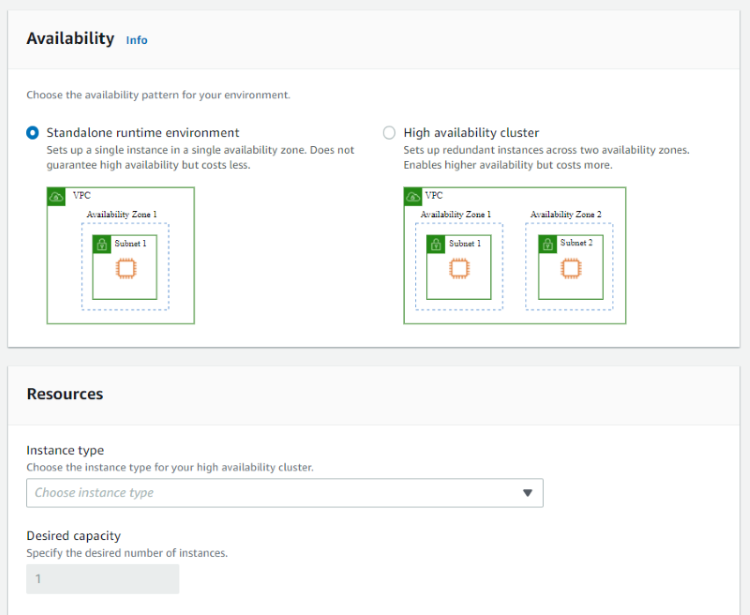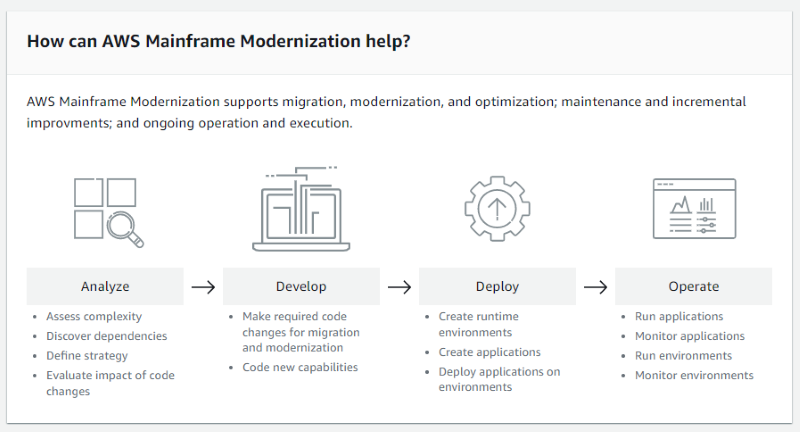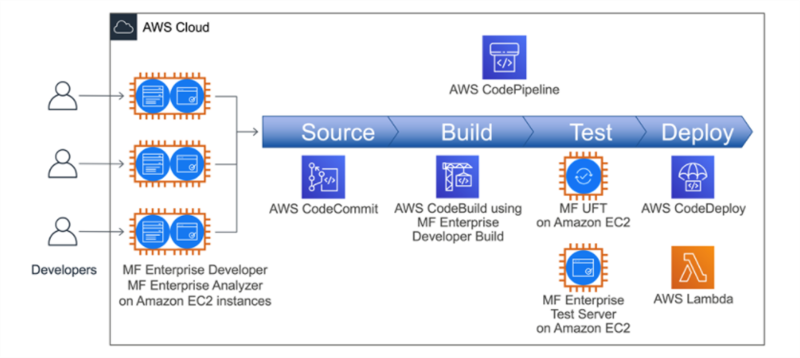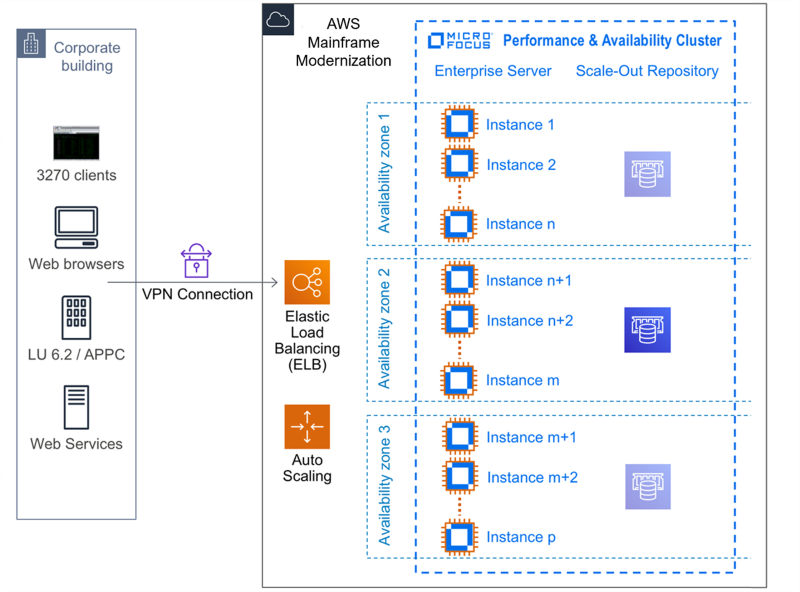Key Questions and Answers: The AWS Mainframe Modernization service
Key questions
How do I know my applications will run with the same reliability and performance as the mainframe if I move them to the AWS Mainframe Modernization service?

AWS mainframe modernization environment provisioning
AWS is the platform of choice for many of the world’s largest workloads and is a leader in moving application workloads to the cloud while preserving high availability, resiliency, and elasticity. AWS Cloud computing resources are housed in highly available data center facilities. To provide additional scalability and reliability, these data center facilities are located in different physical locations. These locations are categorized by AWS Regions and Availability Zones. AWS Regions are large and widely dispersed into separate geographic locations. Availability Zones are distinct locations within an AWS Region that are engineered to be isolated from failures in other Availability Zones.
Do I need to learn a whole new toolset to develop, maintain, and operate my mainframe application?

Yes and No. The AWS Mainframe Modernization service takes care of most of the work in managing a high performance, high availability, and elastic runtime infrastructure environment for your application. The skills your organization has developed to build and manage other AWS workloads apply to the AWS Mainframe Modernization service as well as it has been developed to embrace the AWS management and monitoring ecosystem.
Additionally, administrators and security specialists will need to understand how to operate the AWS tools for identity management.

Example CI/CD DevOps Pipeline for a mainframe application
When re-platforming applications using the AWS Mainframe Modernization service, developers can continue to develop and maintain their existing COBOL and PL/I applications using the Rocket® Enterprise Developer (formerly part of Micro Focus) and Rocket® Enterprise Analyzer (formerly part of Micro Focus) tools. The service enables a more agile/DevOps focus by integrating with AWS services such as AWS CodeCommit, AWS CodeBuild, AWS CodePipeline and others to create an end-to-end pipeline. Look out for the blog around Enabling CI/CD pipelines on the managed service for more details
How does the AWS Mainframe Modernization platform ensure my applications perform under load?

AWS Mainframe Modernization encapsulating Enterprise Server – High Availability Cluster
The service allows you to define an environment for your applications to run under and allows you to specify the machine type, sizes, and capacity in the environment to run your workload. Within the service, Rocket® Enterprise Server (formerly part of Micro Focus) performance and availability clusters (PACs) are running that enable autoscaling based on real-time metrics to spin up and spin down as user demand peaks and wanes.
Once I have deployed my application to the Rocket Software Mainframe Modernization service how do I deliver faster to keep pace with changing requirements in the business?
Rocket® Enterprise Developer (formerly part of Micro Focus)is an integrated development environment included with the AWS Mainframe Modernization service. It enables COBOL and PL/I developers to have the same rich set of development productivity features that are available to C# and Java developers. With access to smart editing, application knowledge, graphical debugging, unit testing and test automation, organizations can address mainframe skills concerns, remove deployment pipeline bottlenecks, and enable the latest DevOps practices. The result is faster code changes for your core business applications that can be tested earlier resulting in higher code quality, delivered faster.
What differentiates re-platforming my mainframe application to the AWS Mainframe Modernization service over other methods such as rewriting?
There are several valid approaches to modernizing mainframe applications. A key factor in deciding the best approach is to understand your business factors and drivers for change. It is exceedingly rare that there will be a “one size fits all approach”.
Rewriting your COBOL and PL/I application to another language can be a viable approach for smaller, less complex applications where a premium is being put on incorporating business and functional enhancements during a modernization project. Nonetheless this approach should be restricted to projects with limited scope and duration.
For more complex applications where the drivers are to remove platform dependencies while minimizing change, impact, and time to production, application re-platforming via the AWS Mainframe Modernization service is a minimal-risk, expedient approach. Re-platforming preserves your application code and data models while also bringing the many benefits of AWS Cloud resiliency, elasticity, and agility including a more agile DevOps development and delivery model.
How will I know access to the applications is protected and my data is secure?
Mainframe security is AWS’ top priority. AWS has been architected to be one of the most flexible and secure cloud computing environments available today. AWS core infrastructure is built to satisfy the security requirements for the military, global banks, and other high-sensitivity organizations. AWS uses the same secure hardware and software to build and operate each of our regions, so all customers benefit from service offerings, and associated supply chains are vetted and accepted as secure enough for top-secret workloads. This is backed by a deep set of cloud security tools, with more than 230 security, compliance, and governance services and key features.
The AWS Mainframe Modernization service inherits the same AWS-proven policies, architecture, and operational processes built to satisfy the security requirements of your enterprise and harmonizes the security of your mainframe applications with other cloud applications in your portfolio. Under the hood of the Mainframe Modernization service, Rocket Enterprise Server addresses confidentiality, integrity, and compliance concerns by providing extensive encryption of data both at rest and in transit, with minimal or no application changes.
TCP-based communication endpoints for application access can be encrypted using TLS (SSL) for data in motion. Access to the applications can leverage AWS Virtual Private Network (AWS VPN), either over the internet or private network using AWS Direct Connect, to connect on-premises sites to AWS.
Next steps – start your modernization journey now
The AWS Mainframe Modernization service accelerates your modernization journey by providing a consistent, repeatable, and patterned way to move applications to the cloud. Risk is greatly reduced and time to modernize is shortened by leveraging the managed runtime platform which handles many aspects of the deployment process and provides the elastic, high-availability infrastructure with just a few clicks.
Data at-rest is encrypted with Amazon RDS encryption, as well as with Amazon EFS/FSx encryption, all of which benefit from centralized keys in AWS Key Management Service (AWS KMS) or in the AWS CloudHSM hardware security module.
Authentication and authorization to applications can be configured to model existing mainframe security server rules and be secured via LDAP, IAM and AWS Cognito.
Related posts
Solutions Designed to Empower Developers and Scale IT Impact
Highlighting recent updates and enhancements to Rocket Software’s Skills & Efficiency solutions designed to help fuel even greater innovation.
Understanding the AI-driven Prompt Engineering competency framework
Understanding E-Invoices: A Comprehensive Guide
We will delve into how Rocket® EDX can help you with e-invoices.